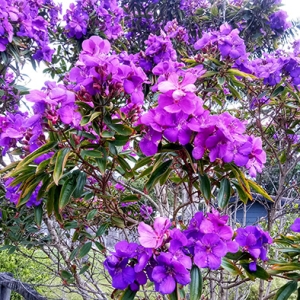The power of three.
 by Mark Evans
by Mark Evans
‘Omne trium perfectum’ is a Latin phrase that translates to ‘everything is perfect in threes’. It is a pervasive concept throughout human culture, be it literature (three little pigs), rhetoric (I came, I saw, I conquered), advertising (slip, slop, slap), the colours of a country’s flag, (red white and blue), comedy (three people walk into a bar) or music (the third note of every scale provides the most basic harmony). The rule of three satisfies the pattern-seeking behaviour in all of us and is equally applicable in the garden.
Three colours: choose colours that complement each other and remember that foliage counts as a colour as well. Three different plants in flower at any one time are enough to give the feeling that a garden is in full bloom, especially when repeated throughout.
Three textures: try and maintain an even mixture of clumping grasses, large-leafed shrubs, and smaller-leaved perennials.
Three heights: plant creeping, or low-growing plants at the front of the bed, medium height perennials or grasses towards the middle and taller shrubs to the rear.
Three plants: an odd number of plants can be arranged in an irregular cluster, which looks more natural than a straight line or a block shape.
Three pots and three plants in each: for the ultimate ‘triple trio’ cluster a group of three different sized pots and plants – a ‘thriller, a filler and a spiller’ in each. Thrillers are the tallest plants and are planted in either the centre or the back of the pot. Fillers are mid-size, mounding or rounded plants that surround the thriller and make the pot look full. Spillers are trailing plants that cascade and tumble over the sides of the pot, softening the edges. Scale the concept up or down in relation to the size of the pots you are using.
Meanwhile, around the town gardens the tibouchinas are really the stars of the show at this time of the year. Every garden should have one as they come in a range of sizes to suit any situation. Now is also the time to plan for a splash of winter colour by planting out a few punnets of the cooler-weather-loving annuals such pansies, violas, primula or polyanthus.
 In the wild places, on the sides of the road around the Triangle, look out for yellow dots at shrub level as Acacia terminalis (sunshine wattle) begins to flower. Mostly growing to around two metres tall, with dark green pinnate leaves, this is one of our few wattles that flower in cold weather.
In the wild places, on the sides of the road around the Triangle, look out for yellow dots at shrub level as Acacia terminalis (sunshine wattle) begins to flower. Mostly growing to around two metres tall, with dark green pinnate leaves, this is one of our few wattles that flower in cold weather.
This month in the vegie garden, the first peas and snow peas should be coming on and to keep the crop producing you can do another follow-up planting. If you love, or want to try, broad beans then it’s the perfect time to pop in some seeds. You can sow some more lettuce (if the seeds from the last crop aren’t already popping up!) and alliums such as onions, garlic, leeks and eschalot bulbs will also do well if planted this month.
Finally, if you have any comments, gardening questions or plant or pest identification problems, please send them through to gardening@thetriangle.org.au and I will endeavour to help.
Happy growing.
Pic 1: The satisfying balance of three
Pic 2: Tibouchina lepidota ‘Alstonville’


